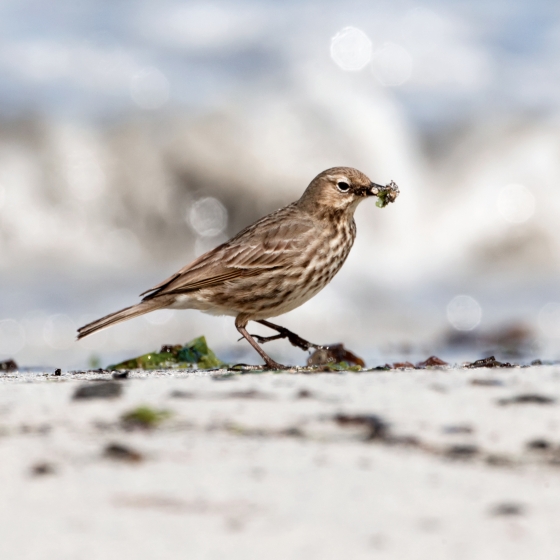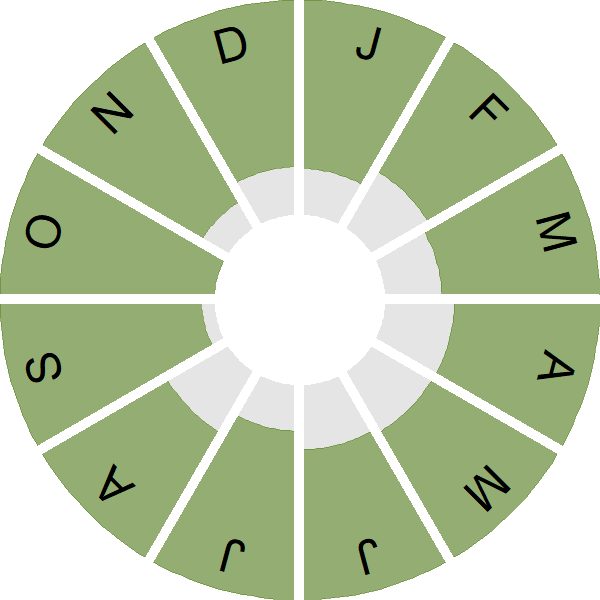Rock Pipit

Introduction
Grey and streaky, with dark legs, the Rock Pipit is a denizen of our rocky shoreline throughout the year.
The Rock Pipit is rarely seen away from the coast. However, during the winter months the largely resident population is joined by migrants from northern Europe and at this time birds of the Continental race can occasionally be seen inland, but nearly always along the 'rocky' edges of manmade lakes and reservoirs.
Data from ringing give insight into the resident and migrant populations. The resident birds move very little during their lifetime, whilst some of the migrant birds fly thousands of kilometres in a season.

Key Stats
Identification
ID Videos
This section features BTO training videos headlining this species, or featuring it as a potential confusion species.
Rock Pipit and Water Pipit
Songs and Calls
Song:
Call:
Status and Trends
Conservation Status
Population Change
The breeding population and trend of the Rock Pipit is poorly understood. It is too common to be monitored by the Rare Breeding Birds Panel and yet not sufficiently common or widespread to be monitored by the Breeding Bird Survey. Furthermore, its specialist habitat requirements and the fact that it is not thought to be declining mean that it is not covered by occasional surveys which monitor other less common species (e.g. breeding wader surveys). It is found around most of the coasts of the UK wherever suitable rocky habitat exists with gaps where the only habitats are sandy beaches and saltmarsh, such as along much of the east coast of England (Balmer et al. 2013). There has been little change in the number of occupied 10-km squares since the 1968–72 Atlas (Balmer et al. 2013), suggesting stability. However, the population estimate for Rock Pipit, of 34,000 pairs (APEP4), is based on the data from the 1988–91 Bird Atlas (Gibbons et al. 1993) and has never been updated.
Distribution
Breeding Rock Pipits are stringly tied to rocky coasts and are absent from long stretches of low-lying coasts characterised by saltmarshes, mudflats or sandy beaches. The highest breeding densities are in western Ireland, southwest Wales, the Hebrides and Northern Isles. The winter distribution remains almost exclusively coastal but enlarges to include the saltmarshes of eastern England, these being inhabited by migrant Rock Pipits from Fennoscandia.
Occupied 10-km squares in UK
2007/08–10/11
or view it on Bird Atlas Mapstore.
2008–11
or view it on Bird Atlas Mapstore.
European Distribution Map
Distribution Change
Little is known about trends for breeding Rock Pipits. Range changes have been modest but there is evidence of localised population declines on some Scottish islands.
Change in occupied 10-km squares in the UK
from 1981–84 to 2007–11
or view it on Bird Atlas Mapstore.
from 1968–72 to 2008–11
or view it on Bird Atlas Mapstore.
Seasonality
Rock Pipit is recorded year-round, with a distinct peak in autumn during passage.
Weekly pattern of occurrence
The graph shows when the species is present in the UK, with taller bars indicating a higher likelihood of encountering the species in appropriate regions and habitats.

Movement
Britain & Ireland movement
Foreign locations of birds ringed or recovered in Britain & Ireland
Dots show the foreign destinations of birds ringed in Britain & Ireland, and the origins of birds ringed overseas that were subsequently recaptured, resighted or found dead in Britain & Ireland. Dot colours indicate the time of year that the species was present at the location.
- Winter (Nov-Feb)
- Spring (Mar-Apr)
- Summer (May-Jul)
- Autumn (Aug-Oct)

European movements
EuroBirdPortal uses birdwatcher's records, such as those logged in BirdTrack to map the flows of birds as they arrive and depart Europe. See maps for this species here.
The Eurasian-African Migration Atlas shows movements of individual birds ringed or recovered in Europe. See maps for this species here.
Biology
Productivity and Nesting
Nesting timing
Egg measurements
Clutch Size
Incubation
Survival and Longevity
Survival is shown as the proportion of birds surviving from one year to the next and is derived from bird ringing data. It can also be used to estimate how long birds typically live.
View number ringed each year in the Online Ringing Report.
Lifespan
Biometrics
Wing length and body weights are from live birds (source).
Wing length
Body weight
Ring Size
Classification, names and codes
Classification and Codes
- Order: Passeriformes
- Family: Motacillidae
- Scientific name: Anthus petrosus
- Authority: Montagu, 1798
- BTO 2-letter code: RC
- BTO 5-letter code: ROCPI
- Euring code number: 10142
Alternate species names
- Catalan: grasset de costa
- Czech: linduška skalní
- Danish: Skærpiber
- Dutch: Oeverpieper
- Estonian: randkiur
- Finnish: luotokirvinen
- French: Pipit maritime
- Gaelic: Gabhagan
- German: Strandpieper
- Hungarian: parti pityer
- Icelandic: Strandtittlingur
- Irish: Riabhóg Chladaigh
- Italian: Spioncello marino
- Latvian: akmenu cipste
- Lithuanian: uolinis kalviukas
- Norwegian: Skjærpiplerke
- Polish: swiergotek nadmorski
- Portuguese: petinha-marítima
- Slovak: labtuška skalná
- Slovenian: obalna vriskarica
- Spanish: Bisbita costero
- Swedish: skärpiplärka
- Welsh: Corhedydd y Graig
- English folkname(s): Tangle Sparrow
Research
Causes of Change and Solutions
Causes of change
The little knowledge we have of this species suggests that there has been no substantial change in its status. Its preference for rocky coastal habitats is likely to mean that, in contrast to most other species depending on other habitats in the UK, the Rock Pipit has been relatively undisturbed and its habitat has remained relatively unchanged. However, given the lack of knowledge about the population trends for this species further research would be prudent, both to confirm that the population is stable and to better understand the requirements of this species.
More Evidence
More evidence from Conservation Evidence.com
Partners
Citing BirdFacts
If you wish to cite particular content in this page (e.g. a specific value) it is best to use the original sources as linked in the page. For a more general citation of the whole page please use: BTO (20XX) BirdFacts Species: profiles of birds occurring in the United Kingdom. BTO, Thetford (www.bto.org/birdfacts, accessed on xx/xx/xxxx).

